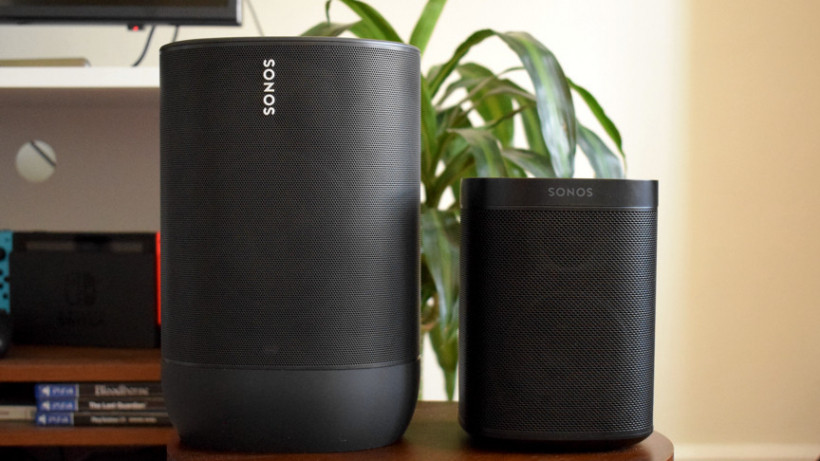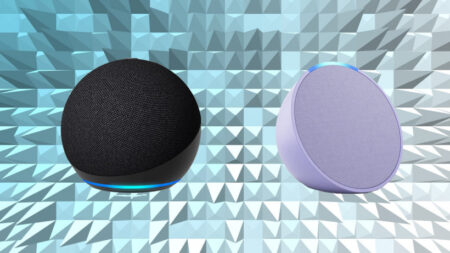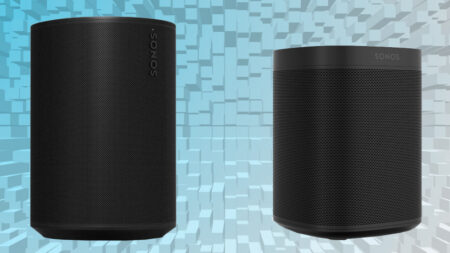How portable do you want your Sonos sound?
Sonos has been cracking out high-quality multiroom audio with easy integration and great sound quality for years, but the Sonos Move was its first ever portable speaker.
It’s far from a lightweight offering – unlike the newer Sonos Roam – but it does bring serious sound to the table, and lets you switch between docked and portable modes on the fly.
All that could spell a bit of trouble for the Sonos One, which has until now been the obvious entry point for those choosing the best Sonos for their needs.
Below, we’ve compared the two across a few different categories, from design to features and the all-important sound quality question.
Sonos Move v Sonos One: Design

There’s one really major design difference between the Sonos Move and the Sonos One, and it’ll slap you in the face if you place them side-by-side: the Sonos Move is a lot bigger than the One.
The One, which has had a couple of generations now, is a relatively dinky little number. But, for its size, it packs some real sonic muscle, more of which later. The One has got the textbook Sonos looks, too – subtle and refined.
It’s got an all-over grille, hiding the drivers, and a chunky power cord to plug in to get it all going. If you’re looking for a speaker that won’t upset your carefully calibrated decor, the Sonos One is unlikely to offend.
- Biggest differences: Sonos One v One SL
Sliding over to the Move, Sonos has bumped up its speaker’s profile significantly (and made the logo contrasting to stand out a little more).
It’s also got a hefty weight to it, 3kg to match its 10-inch height, meaning it’s not quite as portable as some might hope. However, the size allows it to pack in that all-important battery and some better speakers than the One.
The Move has a charging cradle that it sits on to power up, but you can place it anywhere you like when it’s in Wi-Fi mode – until the battery runs out.

Of course, with the Move equipped to journey outside, Sonos has thought about all the bad things that could await it in the great outdoors. For example, it’s been careful to make sure you can drop and abuse the Move (within reason) without breakage. It’s also got IP65 water and dust resistance to make sure that anything short of a full-on water dunking should pose no problem.
The Move also has a rubber bottom to give it a sturdier base for standing on whatever surface is available, and that’s particularly useful for outside where it might be placed on grass, mud, or any other dirty or uneven surface.
- Diddy designs: Amazon Echo 4 vs Apple HomePod Mini
Both the One and the Move have the same touch buttons on their tops, giving control over volume and the microphones, as well as play and pause. The Move also has a power button and Bluetooth button on its rear, to let you turn the speaker on and off, or connect it to a new source while on the go.
The Move’s back button area is actually recessed into the speaker, creating a handle you can use to pick the Move up and carry it around.
Sonos Move v Sonos One: Features

There are some key feature differences to be aware of here.
The most obvious one is what we’ll tackle first: the Sonos Move is a portable Bluetooth speaker and Wi-Fi smart speaker in one. You can take the speaker out and about by lifting it off its charging cradle, and expect 10 hours of playback use before needing to recharge it.
If you put it in low-power mode (which it will do automatically after 30 minutes), you could come back to it up to five days later and still be able to use it. It all means you don’t have to think too much about it, given that it’s also a wired smart speaker when you need it to be.
One more advantage that the Move brings to the table is the evolution of Sonos’ Trueplay feature, which now works automatically. For its other speakers, including the One, Sonos allows iOS users to wave their phones around during setup, while the speaker makes loud noises, to work out the best sound profile for the space it’s in.
Read next: The ultimate guide to your Sonos multi-room audio system
But the Move will adjust its sound profile on the fly, ensuring it’s optimizing the sound at all times. That’s a great change and a far easier way to get better sound.
At launch, Auto Trueplay only worked when the Move was connected to your Wi-Fi. When you changed to Bluetooth mode, it switched to a more fixed sound profile.
However, when Sonos announced its smaller portable speaker in March 2021, the Sonos Roam, the speaker specialist updated the software of the Move, so that Auto Trueplay now works over Bluetooth, as well.
Beyond those key distinctions, there’s a whole lot of common ground between the Move and the One. Both feature the gamut of Sonos connectivity – from joining your Wi-Fi network of multi-room speakers to AirPlay 2 and the ability to pair two units for stereo sound.
They also both have smart assistant functionality built-in, with Alexa or Google Assistant available according to preference. It’s worth noting, though, that the Move’s smart assistant feature is Wi-Fi dependent, so when you switch it over from Wi-Fi to Bluetooth, you’ll be limited to Bluetooth playback only, with no help from Alexa or Google.
Sonos Move v Sonos One: Sound quality
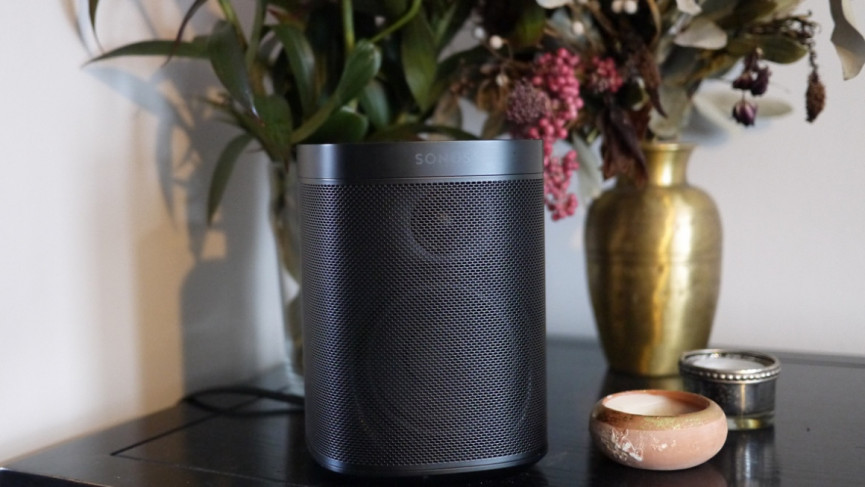
Sonos made its name for a reason – its speakers have some of the best sound on the market outside of true enthusiasts and hugely expensive systems.
In terms of sound, there’s an immediate break between the Move and One – and it only takes a few seconds of listening to realize the Move has the superior sound. The One has always felt like its middle ranges were hollowed out, while the Move has a more balanced range that puts it closer to the Sonos FIVE in terms of quality.
- Soundbar showdown: Sonos Beam vs Sonos Arc
The Sonos Move actually has the same mid-woofer driver as Sonos’ Play:5, along with two Class-D digital amplifiers and a downward-firing tweeter. The One also has two Class-D amps and a mid-woofer, but the core difference in sound is volume. In short, the Move can crank a lot louder. It’s got a wider soundstage, and cleaner delivery (if it’s pointing at you).
Sonos wanted to produce a portable speaker that wouldn’t necessarily irk neighbors or passersby in all directions, which is why the Move doesn’t project behind itself. Stand behind it and it doesn’t sound nearly as good.
Really, though, these are both great-sounding speakers. The Move is bolder and louder in sound, but, for most people’s purposes, the One’s maximum volume is plenty loud enough. The Move is also slightly higher quality in terms of audio finish, but, again, the One is already setting a great standard.
Sonos Move v Sonos One: Price
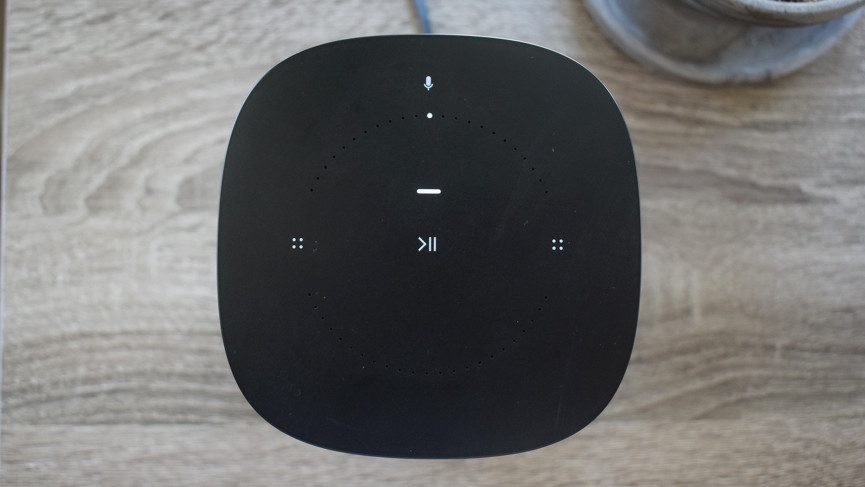
You might be noticing a theme here – there’s also a pretty significant difference when we turn to the prices of the Sonos Move and One.
The Move costs $399 / £399, which is expensive from pretty much every angle. It’s a heck of a lot for a Bluetooth speaker, and a serious whack for a smart speaker.
Then again, it’s both of those things, and is pretty close to best-in-class in both categories on the performance side, which is also quite a boast.
The Sonos One by contrast, older but proven, is priced at £189, although as an established device it’s a little bit more likely to get the occasional discount. That’s half the price of the Move – so for the price of one Move you could get a paired stereo set of Ones for your living room, or to contribute to a surround sound system for your TV.
Sonos Move v Sonos One: Which is the best?

The Sonos Move was indicative of a pretty radical new strategy from Sonos, moving out of the home and into a market that it previously spent so long ignoring. We’ve been incredibly impressed by all its usual Sonos strengths, too.
It’s got top-quality sound, great build quality, and adaptability. Being able to rely on brilliant sound in your home, in parks and on camping trips is great, and opens up a whole new world for Sonos.
If you’ve been waiting on tenterhooks for Sonos to give you a portable option, it’s a no-brainer. But, but, at £399 it’s currently a pricey choice, and Sonos isn’t known for frequent discounts – and portability at a much cheaper price tag is now available with the Roam.
The One is a proven champion of the smart home. It’s got a great sound and the same smart home capabilities as the Move, and it’s half the price.
If you’re looking to get into Sonos for the first time, the Sonos One is still the sensible choice. It will get you started and is plenty modular, so you can easily build from it.
But if you’re a partier, or if the booming sound in the open air appeals, the Move is a new favorite of ours, and won’t disappoint.
The good news is that there’s no wrong choice here, really. Both speakers are excellent – so which do you think you’ll go for? Let us know your thoughts in the comments below, and throw us any questions we haven’t addressed above.


